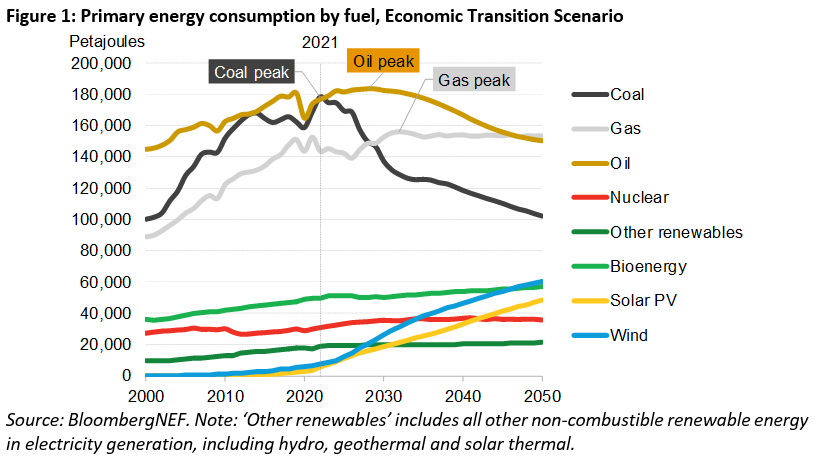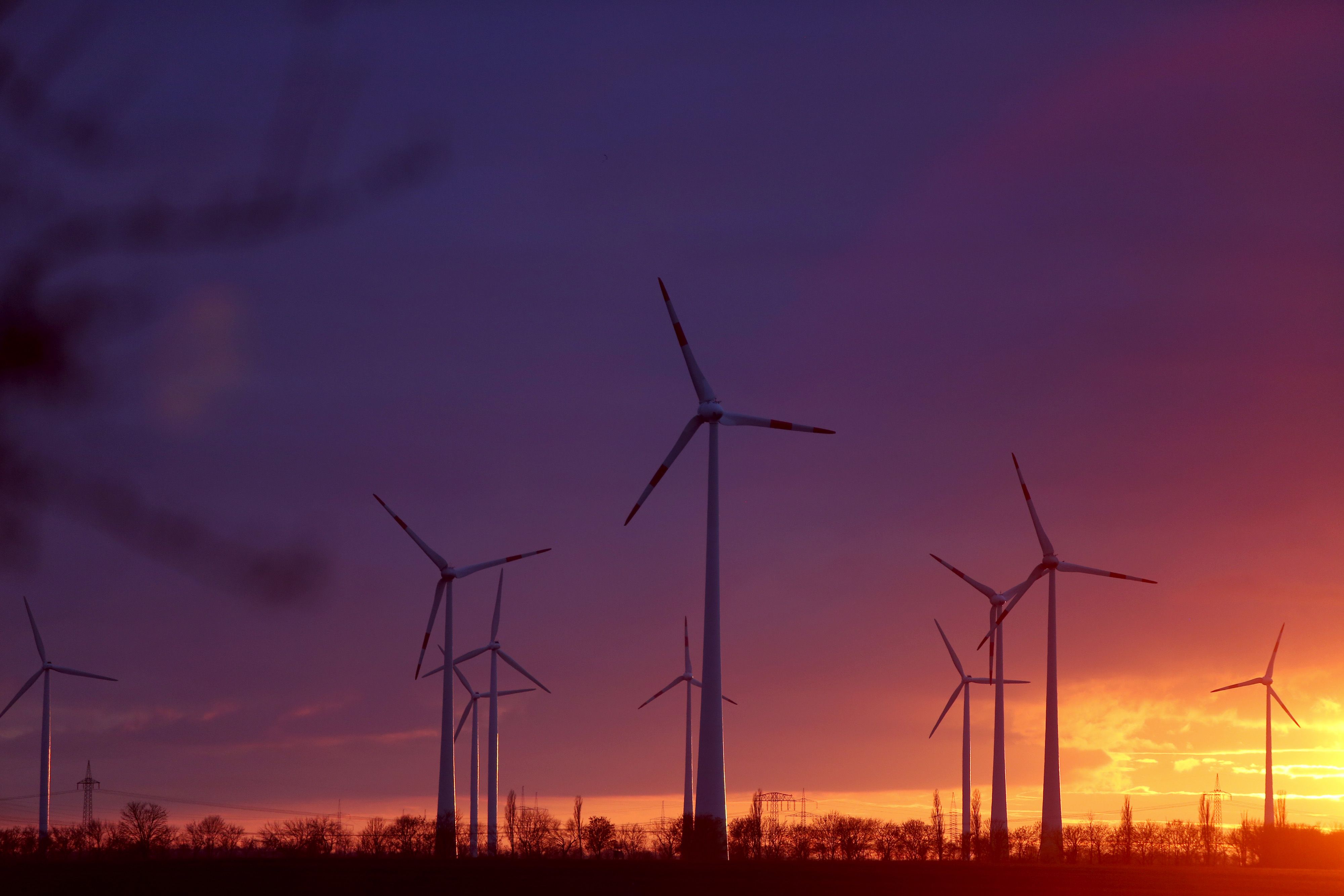PRESS RELEASE
New Energy and Climate Scenario Shows a Path to Stay on Track for Paris Agreement Goals
BloombergNEF’s New Energy Outlook 2022 demonstrates a credible way to achieve global net zero by mid-century
London, November 30, 2022 – Plausible pathways still exist to get on track for well below two degrees Celsius of global warming, if governments and companies take determined action to transition to low-carbon energy technologies, according to the 2022 New Energy Outlook, by research company BloombergNEF (BNEF). The report comes in the wake of the COP27 UN climate change conference, which delivered no meaningful increase in ambition in the fight against global warming.
The BNEF New Energy Outlook explores how the world’s energy system, and the energy systems of nine critical countries that make up 63% of global emissions, may evolve between now and 2050, under two scenarios: the so-called Economic Transition Scenario, and the Paris-aligned Net Zero Scenario.
Economic Transition Scenario
The global energy crisis has made renewable energy even more competitive against coal-and gas-fired power generation in many parts of the world as the prices of those fuels have jumped, and many countries and regions are pursuing a faster transition to clean energy in support of a push for greater energy security.
In the Economic Transition Scenario (ETS), which assumes no new policy action to accelerate the clean energy transition, the rapid growth of renewable energy and electrification of transport eliminate about half of the world’s energy-related emissions in 2050, against a baseline where no such transition takes place. These technologies win on their own merit, without need for additional subsidy, thanks to the dramatic cost reductions in wind, solar and battery technology over the last decade – which are expected to resume following a hiatus during the current inflationary crunch.
Wind and solar provide about two-thirds of the world’s power generation by 2050 in the ETS, and these two technologies, combined with battery storage, account for an overwhelming 85% of the 23 terawatts of new power capacity additions installed over the next three decades. Power sector emissions fall by 57%, and emissions in the overall transportation sector fall by 22% to 2050, driven by the road segment’s transition to electric vehicles. Global coal, oil and gas use all peak over the next decade, with coal reaching a high point and starting to decline immediately, while oil does the same in 2028 and gas in the early 2030s.
Matthias Kimmel, team leader for energy economics at BNEF, said: “The energy transition in the power sector is well under way, and our modeling shows global emissions in the power sector peak around 2023. Despite the recent inflationary pressures, renewables remain competitive and the gap between renewables and fossil fuels continues to widen. We’re on the right track, but there is still much more work needed to push for solutions we already know make economic sense.”
Despite these rapid gains for clean energy, the Economic Transition Scenario falls far short of achieving net zero by mid-century. By 2050, emissions have fallen 29%, but unabated coal, oil and gas still emit 24.6 gigatons of CO2 per year. The result is a trajectory consistent with 2.6C of global warming, breaching the goals of the Paris Agreement.

Net Zero Scenario
In the Net Zero Scenario (NZS), BNEF modeling indicates that the world can stay on track for 1.77C, and global net zero by 2050, with rapid deployments of clean power generation, electrification, and, to a lesser extent, carbon capture and storage and hydrogen.
Switching power generation from fossil fuels to clean power is the single biggest contributor to global emissions reduction, accounting for half of all emissions abated over 2022-50. This includes displacing unabated fossil fuel with wind, solar, other renewables and nuclear – largely mature technologies that exist at scale today. By 2050, the global power system is dominated by wind (48% of generation) and solar (26%), with the rest provided by other renewables (7%), nuclear (9%), hydrogen and coal or gas with carbon capture.
Electrification of transport and industrial processes, buildings and heat – using steadily lower-carbon electricity – is the next biggest contributor to emissions reductions, abating about a quarter of total emissions over the period. Here again, the technologies already exist, though in the case of heating for buildings and industry, electrification is not yet proceeding at pace.
The remainder of emissions reductions come from demand-side efficiency gains and recycling, hydrogen, bioenergy and carbon capture and storage, together accounting for roughly the last quarter of emissions reductions. Although these appear to play a smaller role, the growth required for these technologies is still remarkable. Carbon capture and storage capacity grows from about 40 megatonnes in 2021 to 1.7 gigatons by 2030, and over 7 gigatons by 2050. Hydrogen use more than quintuples, from over 90 million tons of largely fossil-based hydrogen today, to about 500Mt of emissions-free hydrogen by 2050.

David Hostert, global head of economics and modelling at BNEF and lead author of the report, said: “Our Net Zero Scenario shows that a credible pathway to meet the goals of the Paris Agreement still exists, but getting there requires immediate action. Clean power deployment needs to quadruple by 2030, in addition to a major investment in carbon capture and storage, advanced nuclear technologies, and hydrogen. To get on track this decade, there needs to be $3 invested in low-carbon supply for every $1 in fossil-fuel supply. There are also critical enabling factors to consider: electrification and economic growth will quadruple the planet’s power demand by 2050. We need to see a massive acceleration in the build-out of power grids, manufacturing capacity for low carbon technologies, and supply of critical metals and materials. These could become painful bottlenecks tomorrow, if left unaddressed today.”
Countries
In the Net Zero Scenario, countries take different routes to net zero. The developed countries covered in the report (the US, UK, France, Germany, Japan and Australia), reduce emissions rapidly in this decade, while developing economies (India, Indonesia and the Rest of World) see emissions rise for several more years before rapidly declining in later years. China charts its own course, blending elements of both developed and developing pathways.
Cleaning up the power system is most impactful in countries that heavily rely on coal today, such as China (61% share of coal in electricity generation in 2021), India (78%) and Australia (53%). Switching to clean power accounts for at least two-thirds of their total emissions abatement over the next 28 years. Electrifying fossil-fuel based processes in transport, industry and buildings should be a priority in countries that have already lowered the carbon intensity of their electricity generation.
Moreover, the report finds that several countries could outperform their officially stated emissions targets, known as Nationally Determined Contributions (NDCs), or increase the ambition of these targets by 2030, relying only on technologies that are economically competitive today, or very soon to be. China, India and Indonesia are all seen easily beating their NDCs in the Economic Transition Scenario and exceeding them by even more in the Net Zero Scenario.
Key actions to accelerate the transition
The report includes prescriptions for six key action areas for policy makers and private sector actors, building on a framework developed by Bloomberg and BNEF for the NetZero Pathfinders initiative. These are:
- Accelerate deployment of mature climate solutions
- Support the development of new climate solutions
- Manage the transition or phase-out of carbon-intensive activities
- Create appropriate climate transition governance structures
- Support the transition in emerging markets and developing economies
- Scale up the supply of critical materials
“Our Net Zero Scenario and Economic Transition Scenario describe very different pathways for the energy transition, and by extension for the global climate crisis, and the fork in the road is upon us. Policy makers returning home from COP27 have an opportunity to start closing the so-called ‘implementation gap’, by removing barriers to the deployment of renewable energy and electric vehicles, accelerating the development of newer technologies like hydrogen and carbon capture, and actively managing the transition away from unabated fossil fuels,” Hostert adds.
Contact
Veronika Henze
BloombergNEF
+1-646-3-1596
vhenze@bloomberg.net






